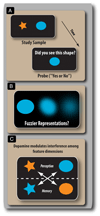Dopamine Alters the Fidelity of Working Memory Representations according to Attentional Demands
- PMID: 27897674
- PMCID: PMC5889096
- DOI: 10.1162/jocn_a_01073
Dopamine Alters the Fidelity of Working Memory Representations according to Attentional Demands
Abstract
Capacity limitations in working memory (WM) necessitate the need to effectively control its contents. Here, we examined the effect of cabergoline, a dopamine D2 receptor agonist, on WM using a continuous report paradigm that allowed us to assess the fidelity with which items are stored. We assessed recall performance under three different gating conditions: remembering only one item, being cued to remember one target among distractors, and having to remember all items. Cabergoline had differential effects on recall performance according to whether distractors had to be ignored and whether mnemonic resources could be deployed exclusively to the target. Compared with placebo, cabergoline improved mnemonic performance when there were no distractors but significantly reduced performance when distractors were presented in a precue condition. No significant difference in performance was observed under cabergoline when all items had to be remembered. By applying a stochastic model of response selection, we established that the causes of drug-induced changes in performance were due to changes in the precision with which items were stored in WM. However, there was no change in the extent to which distractors were mistaken for targets. Thus, D2 agonism causes changes in the fidelity of mnemonic representations without altering interference between memoranda.
Figures





References
-
- Alvarez GA, Cavanagh P. The capacity of visual short-term memory is set both by visual information load and by number of objects. Psychological Science. 2004;15:106–111. - PubMed
-
- Andreotti AC, Pianezzola E, Persiani S, Pacciarini MA, Strolin Benedetti M, Pontiroli AE. Pharmacokinetics, pharmacodynamics, and tolerability of cabergoline, a prolactin-lowering drug, after administration of increasing oral doses (0.5, 1.0, and 1.5 milligrams) in healthy male volunteers. Journal of Clinical Endocrinology and Metabolism. 1995;80:841–845. - PubMed
-
- Arnsten AF. Catecholamine and second messenger influences on prefrontal cortical networks of “representational knowledge”: A rational bridge between genetics and the symptoms of mental illness. Cerebral Cortex. 2007;17:i6–i15. - PubMed
-
- Bäckman L, Nyberg L, Soveri A, Johansson J, Andersson M, Dahlin E, et al. Effects of working-memory training on striatal dopamine release. Science. 2011;333:718. - PubMed
MeSH terms
Substances
Grants and funding
LinkOut - more resources
Full Text Sources
Other Literature Sources

